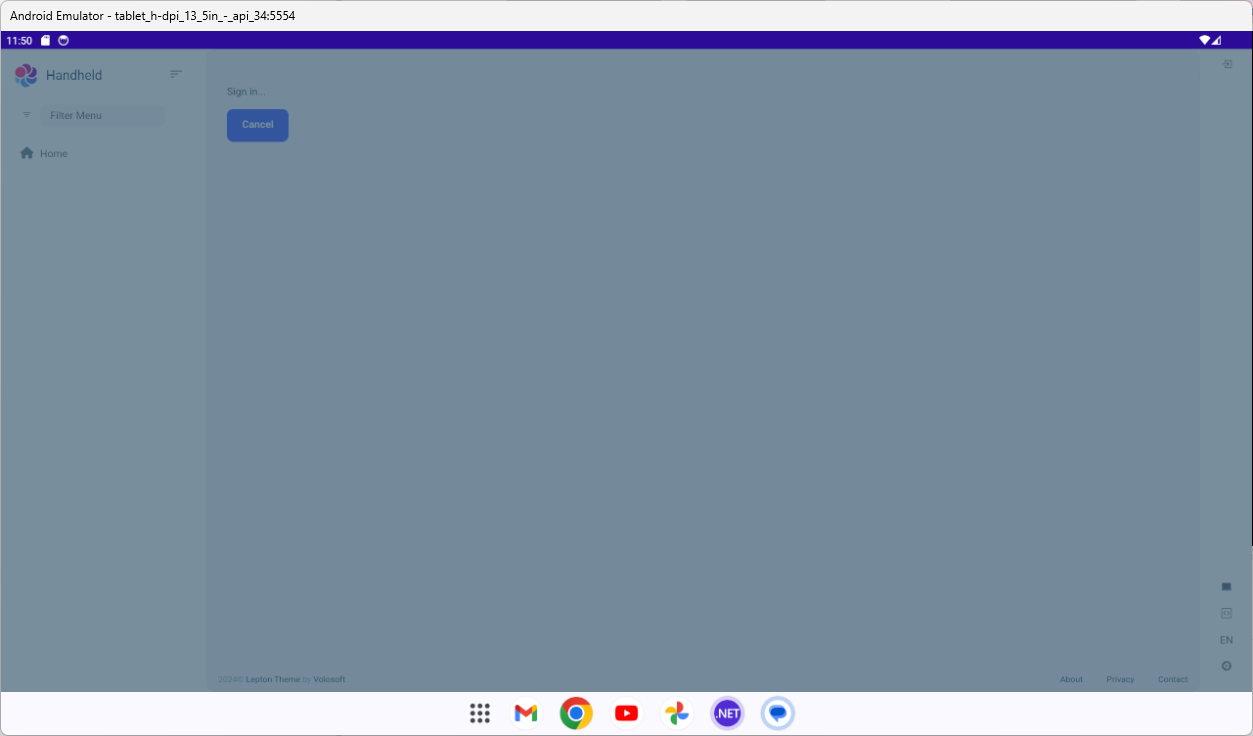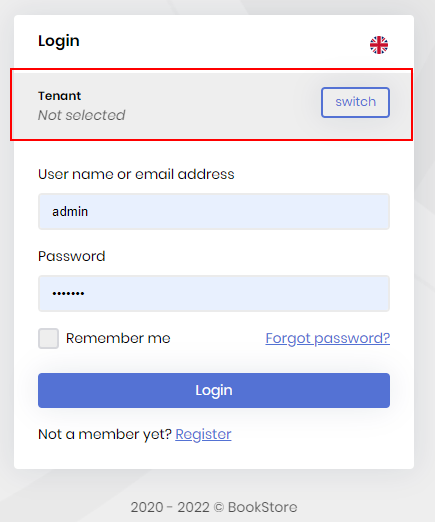Steps to reproduce the issue: We're using the default MAU Blazor (Hybrid) template as created via ABP Studio, and have added the "Login workaround" code as provided here [Maui Blazor (Hybrid) App Can't Login #7908](https://abp.io/support/questions/7908/Maui-Blazor-Hybrid-App-Can%27t-Login)
The solution name is Handheld When the "Server" project Handheld.HttpApi.Host is running and the mobile app Handheld.MauiBlazor is deployed and running on an Android emulator, all works as expected, however when the "Server" project is not running (to simulate the mobile device not having connectivity to the server), the mobile app Handheld.MauiBlazor does not start and throws the above exception in MauiProgram.cs
The reason we're testing this is that the mobile application needs to be able to work when it has no Internet Connectivity as it will be used to take photos as part of vehicle inspections, some of which take place at airfields or ports where Internet connectivity is not always available.
While we realise that none of the "Server" functionality would be accessible via the APIs in the Handheld.HttpApi.Host, we were hoping to be able to test for Network Connectivity using the normal MAUI libraries e.g. Connectivity and switch functionality on/off as appropriate.
The client project (Handheld.MauiBlazor) that is deployed to the mobile device though, appears to perform a lot of calls to the server as part of its "startup code".
Q. As a mobile app that won't start unless it has full internet connectivity is not going to be practicable for us, how might we utilise the ABP Studio MAUI (Blazor Hybrid) template / libraries to achieve this?
We're creating a Maui Blazor (Hybrid) app via ABP Studio. The application when run, cannot Login, it just hangs with the darkened overlay screen and does not reach the Login dialog.
The results are the same whether Android or a Windows Machine is targeted.
 For Android we'd also startup an Android Adb Command Prompt and execute the appropriate command e.g.
For Android we'd also startup an Android Adb Command Prompt and execute the appropriate command e.g. adb reverse tcp:44330 tcp:44330


We also notice that the images on the Home page cannot be resolved, and when a "Windows Machine" is the target which allows us to use F12 Developer Tools and view the console, we can see this

In case its relevant the OpenIddictApplications table contains the following

We're aware of the ABP article on ngrok https://abp.io/community/articles/tunnel-your-local-host-address-to-a-public-url-with-ngrok-4cywnocj and the MS MAUI Team's instructions on using Visual Studio Dev Tunnels (which seems a lot easier) MS MAUI Dev Tunnels with regard to localhost and mobile device development.
So if the ABP Studio generated projects do need subsequent configuration re exposing local host to be able to Login, can you let us know which AppSettings.json files(s) we need to alter, prior to running the **DbMigrator ** project to re-seed the database, in order for us to be able to Login via the Maui Blazor Hybrid App?
Or if this issue is nothing to do with localhost, please advise us on this Login page issue?
Hang then Exception thrown with Blazor (Blazorise) FileEdit and FilePicker controls
<Field>
<FileEdit Changed="OnFileUpload" />
</Field>
using Blazorise;
using System.IO;
using System.Threading.Tasks;
using System;
namespace BookStoreV7.Blazor.Pages;
public partial class Index
{
async Task OnFileUpload(FileChangedEventArgs e)
{
try
{
if (e.Files.Length > 0)
{
var file = e.Files[0];
using var memoryStream = new MemoryStream();
// Next statement hangs, then throws exception
await file.OpenReadStream(int.MaxValue).CopyToAsync(memoryStream);
}
}
catch (Exception ex)
{
//Console.WriteLine(ex.Message);
}
finally
{
this.StateHasChanged();
}
}
}
await file.OpenReadStream(int.MaxValue).CopyToAsync(memoryStream);I can confirm that the FileEdit (and FilePicker) control works in a .Net 7, non ABP Blazor Server app i.e. adding Blazorise to it as detailed here: Blazorise Quick Start Guid It seems to be related to the underlying FileEntry.OpenReadStream() when used in an ABP 7.0.0-rc.2 project.
at System.IO.Pipelines.Pipe.GetReadResult(ReadResult& result) at System.IO.Pipelines.Pipe.GetReadAsyncResult() at System.Runtime.CompilerServices.ConfiguredValueTaskAwaitable`1.ConfiguredValueTaskAwaiter.GetResult() at System.IO.Pipelines.PipeReaderStream.<ReadAsyncInternal>d__30.MoveNext() at System.Threading.Tasks.ValueTask`1.get_Result() at System.Runtime.CompilerServices.ValueTaskAwaiter`1.GetResult() at Microsoft.AspNetCore.Components.Server.Circuits.RemoteJSDataStream.<ReadAsync>d__36.MoveNext() at System.Threading.Tasks.ValueTask`1.get_Result() at System.Runtime.CompilerServices.ValueTaskAwaiter`1.GetResult() at Blazorise.RemoteFileEntryStream.<CopyFileDataIntoBuffer>d__13.MoveNext() at System.Threading.Tasks.ValueTask`1.get_Result() at System.Runtime.CompilerServices.ValueTaskAwaiter`1.GetResult() at Blazorise.RemoteFileEntryStream.<ReadAsync>d__15.MoveNext() at System.IO.Stream.<<CopyToAsync>g__Core|27_0>d.MoveNext() at BookStoreV7.Blazor.Pages.Index.<OnFileUpload>d__0.MoveNext() in C:\Users\Moor Deybe\source\My Stuff\ABPStuff\ABPV7-BookStore\src\BookStoreV7.Blazor\Pages\Index.razor.cs:line 20
We're currently evaluating a Team licence of abp Commercial.
We find the multi tenancy feature very useful, but regarding the login dialog, we'd like to know if we can switch off/hide the Tenant input field during login?
e.g. can we hide this

to achieve the same look and feel as the dialog appears when MultiTenancy is disabled?
e.g.

Asking our users for a tenant name would confuse them no end, as we'd like to just set that ourselves in code after login based upon their TenantId in the corresponding entry for that user in the dbo.AbpUsers table.
We're aware of this example of customising the login dialog Community Post Example
which provides this:
and we have examined this "post" on the subject; https://github.com/abpframework/abp/issues/3752
Q. Can we switch off the input field on the dialog when MultiTenancy is enabled and then set the "current tenant" using a CurrentUserTenantResolveContributor of some sort, or would we need to alter the abp source code as described in the community post above, which we prefer not to do?
We're intending to target blazor-server in case that is relevant.

